Unit 8 Is there a post office near here? 2022-2023学年人教版英语七年级下学期期末复习练习(含解析)
文档属性
| 名称 | Unit 8 Is there a post office near here? 2022-2023学年人教版英语七年级下学期期末复习练习(含解析) | 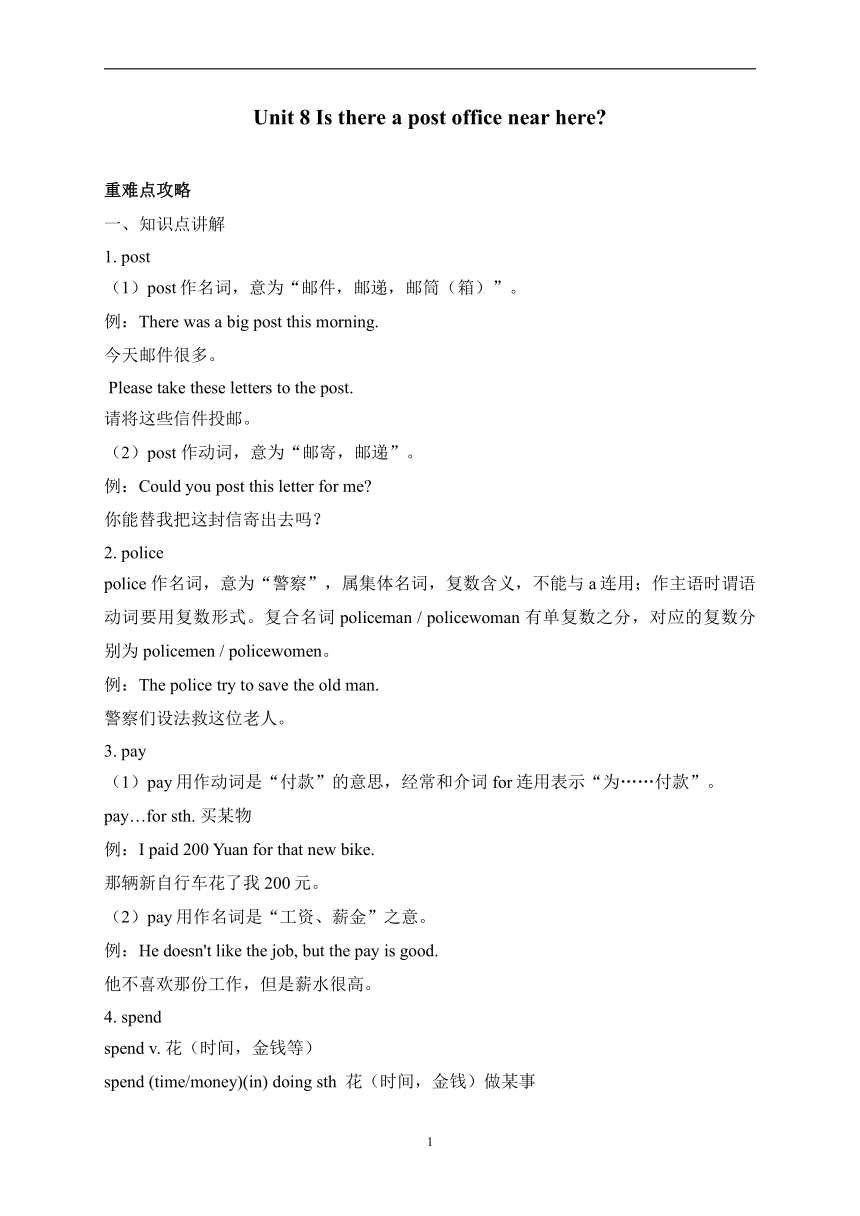 | |
| 格式 | docx | ||
| 文件大小 | 37.0KB | ||
| 资源类型 | 教案 | ||
| 版本资源 | 人教新目标(Go for it)版 | ||
| 科目 | 英语 | ||
| 更新时间 | 2023-06-18 15:18:05 | ||
图片预览

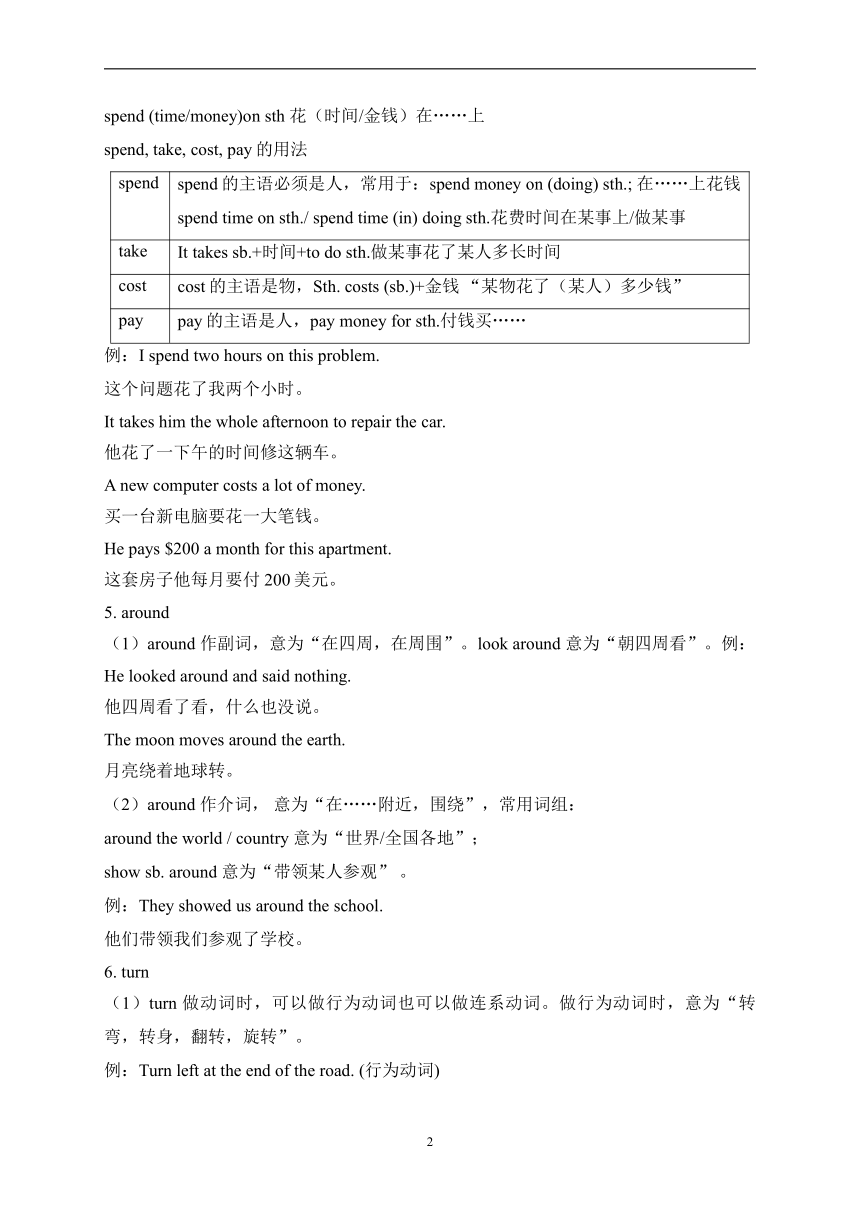
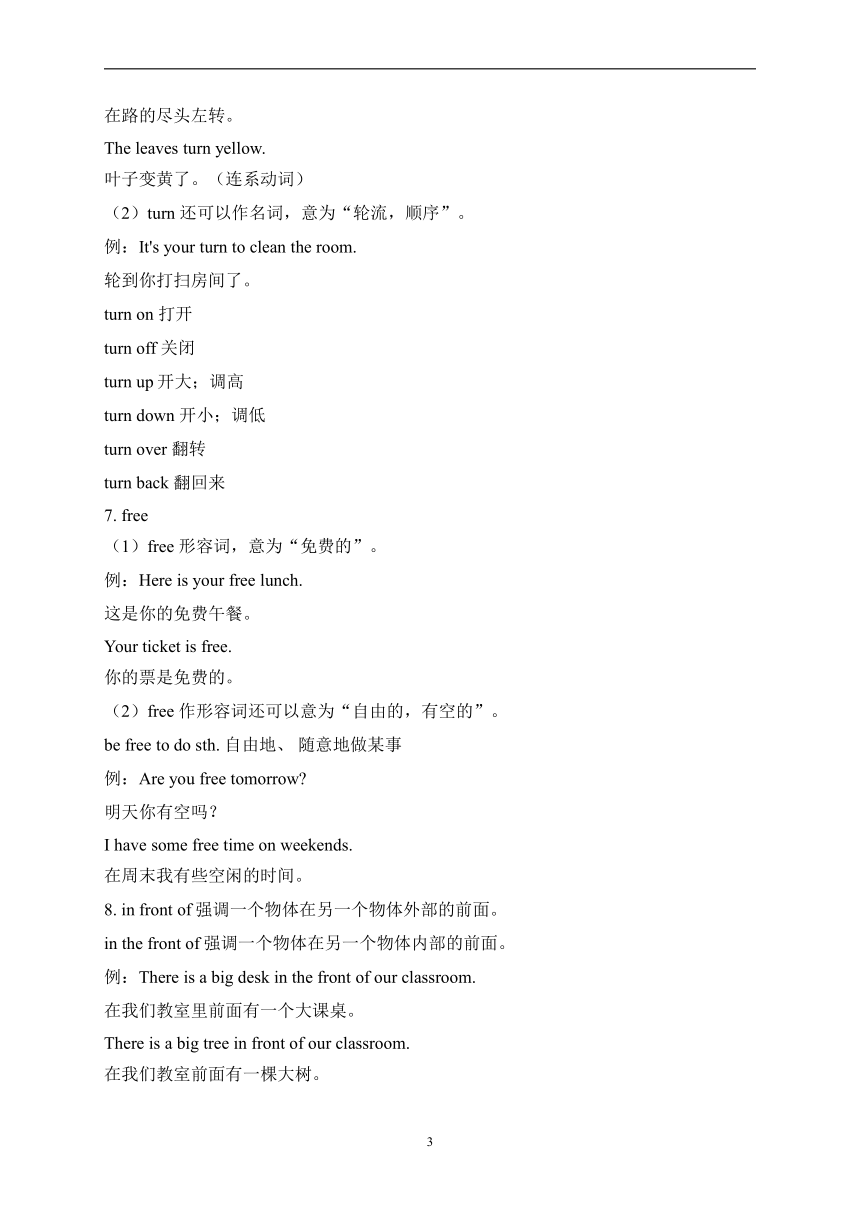
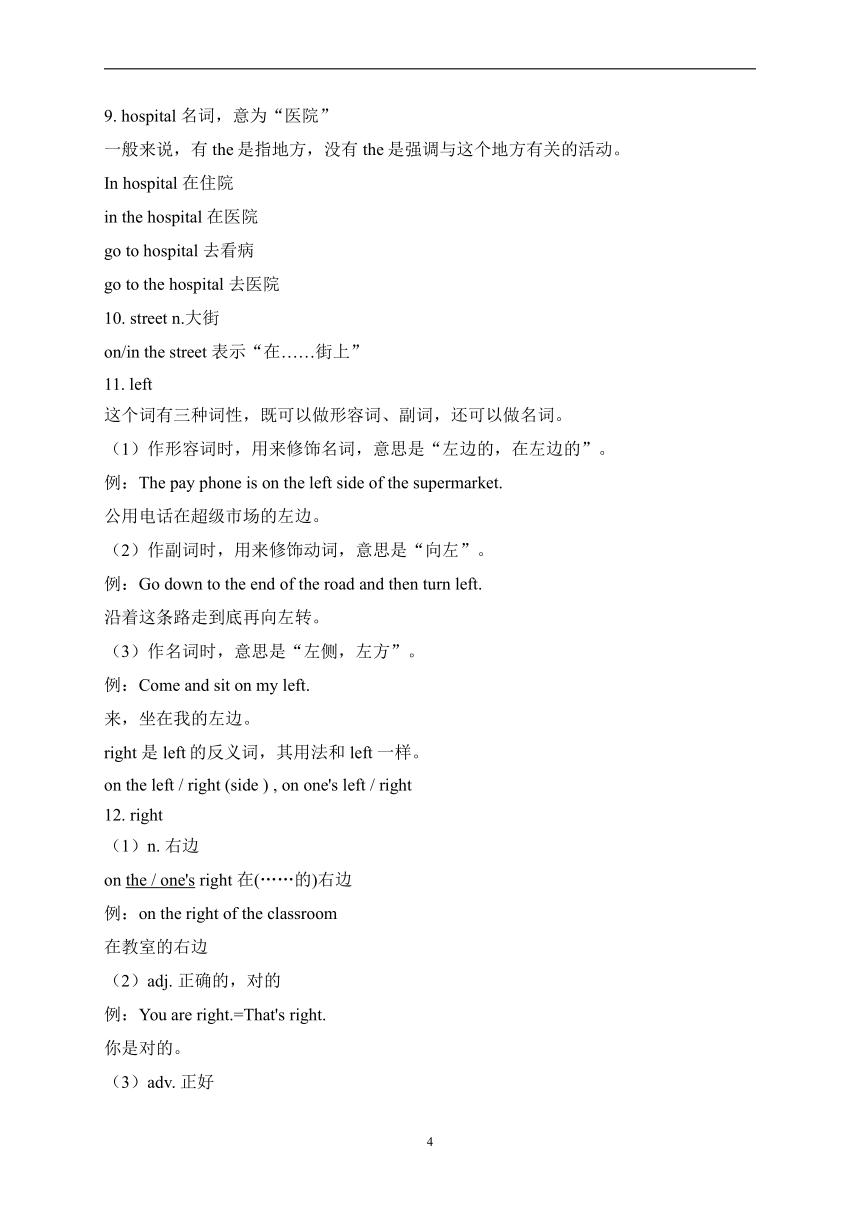
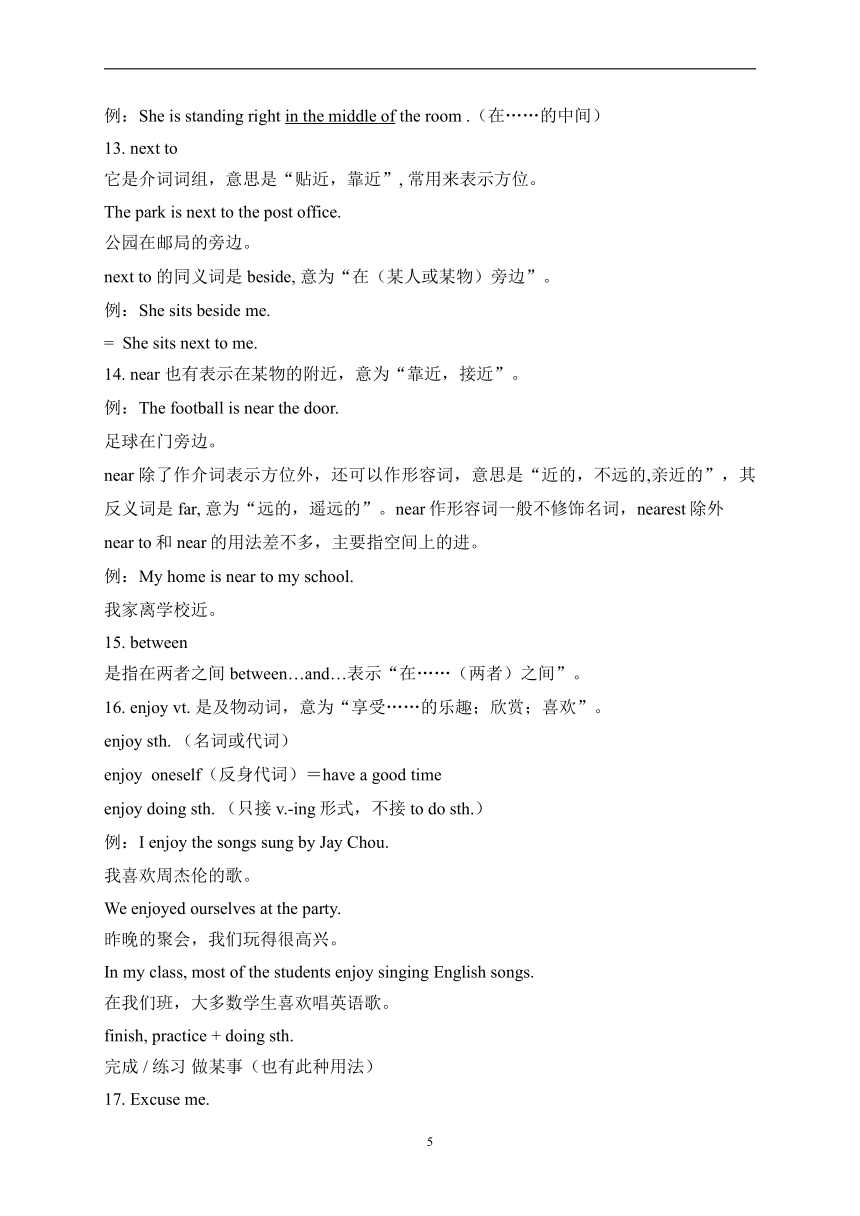
文档简介
Unit 8 Is there a post office near here
重难点攻略
一、知识点讲解
1. post
(1)post作名词,意为“邮件,邮递,邮筒(箱)”。
例:There was a big post this morning.
今天邮件很多。
Please take these letters to the post.
请将这些信件投邮。
(2)post 作动词,意为“邮寄,邮递”。
例:Could you post this letter for me
你能替我把这封信寄出去吗?
2. police
police 作名词,意为“警察”,属集体名词,复数含义,不能与a连用;作主语时谓语动词要用复数形式。复合名词policeman / policewoman 有单复数之分,对应的复数分别为policemen / policewomen。
例:The police try to save the old man.
警察们设法救这位老人。
3. pay
pay用作动词是“付款”的意思,经常和介词for连用表示“为……付款”。
pay…for sth. 买某物
例:I paid 200 Yuan for that new bike.
那辆新自行车花了我200元。
(2)pay用作名词是“工资、薪金”之意。
例:He doesn't like the job, but the pay is good.
他不喜欢那份工作,但是薪水很高。
4. spend
spend v. 花(时间,金钱等)
spend (time/money)(in) doing sth 花(时间,金钱)做某事
spend (time/money)on sth 花(时间/金钱)在……上
spend, take, cost, pay的用法
spend spend的主语必须是人,常用于:spend money on (doing) sth.; 在……上花钱 spend time on sth./ spend time (in) doing sth.花费时间在某事上/做某事
take It takes sb.+时间+to do sth.做某事花了某人多长时间
cost cost的主语是物,Sth. costs (sb.)+金钱 “某物花了(某人)多少钱”
pay pay的主语是人,pay money for sth.付钱买……
例:I spend two hours on this problem.
这个问题花了我两个小时。
It takes him the whole afternoon to repair the car.
他花了一下午的时间修这辆车。
A new computer costs a lot of money.
买一台新电脑要花一大笔钱。
He pays $200 a month for this apartment.
这套房子他每月要付200美元。
5. around
(1)around 作副词,意为“在四周,在周围”。look around 意为“朝四周看”。例:He looked around and said nothing.
他四周看了看,什么也没说。
The moon moves around the earth.
月亮绕着地球转。
(2)around 作介词, 意为“在……附近,围绕”,常用词组:
around the world / country 意为“世界/全国各地”;
show sb. around 意为“带领某人参观” 。
例:They showed us around the school.
他们带领我们参观了学校。
6. turn
(1)turn 做动词时,可以做行为动词也可以做连系动词。做行为动词时,意为“转弯,转身,翻转,旋转”。
例:Turn left at the end of the road. (行为动词)
在路的尽头左转。
The leaves turn yellow.
叶子变黄了。(连系动词)
(2)turn 还可以作名词,意为“轮流,顺序”。
例:It's your turn to clean the room.
轮到你打扫房间了。
turn on 打开
turn off 关闭
turn up开大;调高
turn down 开小;调低
turn over 翻转
turn back 翻回来
7. free
(1)free 形容词,意为“免费的”。
例:Here is your free lunch.
这是你的免费午餐。
Your ticket is free.
你的票是免费的。
(2)free 作形容词还可以意为“自由的,有空的”。
be free to do sth. 自由地、 随意地做某事
例:Are you free tomorrow
明天你有空吗?
I have some free time on weekends.
在周末我有些空闲的时间。
8. in front of强调一个物体在另一个物体外部的前面。
in the front of强调一个物体在另一个物体内部的前面。
例:There is a big desk in the front of our classroom.
在我们教室里前面有一个大课桌。
There is a big tree in front of our classroom.
在我们教室前面有一棵大树。
9. hospital 名词,意为“医院”
一般来说,有the是指地方,没有the是强调与这个地方有关的活动。
In hospital 在住院
in the hospital 在医院
go to hospital 去看病
go to the hospital 去医院
10. street n.大街
on/in the street 表示“在……街上”
11. left
这个词有三种词性,既可以做形容词、副词,还可以做名词。
(1)作形容词时,用来修饰名词,意思是“左边的,在左边的”。
例:The pay phone is on the left side of the supermarket.
公用电话在超级市场的左边。
(2)作副词时,用来修饰动词,意思是“向左”。
例:Go down to the end of the road and then turn left.
沿着这条路走到底再向左转。
(3)作名词时,意思是“左侧,左方”。
例:Come and sit on my left.
来,坐在我的左边。
right 是left的反义词,其用法和left 一样。
on the left / right (side ) , on one's left / right
right
(1)n. 右边
on the / one's right 在(……的)右边
例:on the right of the classroom
在教室的右边
(2)adj. 正确的,对的
例:You are right.=That's right.
你是对的。
(3)adv. 正好
例:She is standing right in the middle of the room .(在……的中间)
13. next to
它是介词词组,意思是“贴近,靠近”, 常用来表示方位。
The park is next to the post office.
公园在邮局的旁边。
next to 的同义词是beside, 意为“在(某人或某物)旁边”。
例:She sits beside me.
= She sits next to me.
14. near 也有表示在某物的附近,意为“靠近,接近”。
例:The football is near the door.
足球在门旁边。
near 除了作介词表示方位外,还可以作形容词,意思是“近的,不远的,亲近的”,其反义词是far, 意为“远的,遥远的”。near作形容词一般不修饰名词,nearest除外
near to和near的用法差不多,主要指空间上的进。
例:My home is near to my school.
我家离学校近。
between
是指在两者之间between…and…表示“在……(两者)之间”。
enjoy vt. 是及物动词,意为“享受……的乐趣;欣赏;喜欢”。
enjoy sth. (名词或代词)
enjoy oneself(反身代词)=have a good time
enjoy doing sth. (只接v.-ing形式,不接 to do sth.)
例:I enjoy the songs sung by Jay Chou.
我喜欢周杰伦的歌。
We enjoyed ourselves at the party.
昨晚的聚会,我们玩得很高兴。
In my class, most of the students enjoy singing English songs.
在我们班,大多数学生喜欢唱英语歌。
finish, practice + doing sth.
完成 / 练习 做某事(也有此种用法)
17. Excuse me.
Excuse me的意思是“对不起、请原谅、打扰一下”。这是英语中经常用到的表示客气的礼貌用语,用于向对方提出请求、询问情况、打扰或者麻烦别人等情景中。Excuse me 具体用于以下几种情况:
(1)向别人问路的时候。
例:Excuse me, where is the bank
劳驾,请问银行在哪里?
(2)客气地向别人提出请求(允许)。
例:Excuse me, may I use your bike
对不起,我可以用一用你的自行车吗?
(3)向别人打听或者询问情况的时候。
例:Excuse me, is this your bike
麻烦一下,这是你的自行车吗?
(4)和别人谈话的时候需要中断或者做别的事情。
例:Excuse me, just a moment.
对不起,请稍等一下。
18. across, over, past与through
(1)across 指从物体表面横向穿过,由一边到另一边。
例:You mustn't go across the street when the traffic lights are red.
交通信号灯是红色的时候,你一定不要穿过街道。
(2)over 多指从物体上方翻越或跨越。
例:He climbed over the mountains to get there. 他翻越高山到达那里。
(3)past 指从物体旁边经过。
例:I go past your house on my way home every day.
我每天回家的路上都经过你家。
(4)through 强调从物体内部或中间/下面穿过。
例:The bird flew in through the window.
这只小鸟是从窗户飞进来的。
19. cross 与 across
(1)cross是动词, 意为“横过,穿过”。
例:Cross the street, and you can see a school.
穿过这条街, 你可以看见一所学校。
(2)across是介词, 意为“横过, 穿过”, 常和表示位置移动的动词go, walk, swim等连用。
例:He walked across the field.
他走过田地。
20. How can I help you 需要我帮忙吗
How can I help you 此句广泛用于商店、饭店、旅馆、邮局等场所,作为对顾客的招呼语。
How can I help you
=Can/May/Could I help you
=What can I do for you
回答时不用yes或no,直接说明需要帮忙的事即可。
例:How can I help you
需要我帮忙吗?
I want some bananas.
我想买些香蕉。
21. in town
表示“说话人所在的城镇”,此时town前不加任何冠词。
Asking ways: (问路)
1. Excuse me. Where is (the nearest) …
打扰了, (最近的)……在哪里?
2. Can you tell me the way to …
你能告诉我去……的路吗?
3. How can I get to …
我怎样到达……呢?
4. Is there…near /around here / in the neighborhood
附近有……吗?
5. Which is the way to …
哪条是去……的路?
6. Can you tell me how to get to...
你能告诉我怎样才能到达
7. Which is the way to…
哪一条是去……的路?
Showing the ways: (指路)
1. Go straight down / along this street.
沿着这条街一直走。
2. Turn left at the second turning.
在第二个路口向左转。
3. You will find it on your right.
你会在你右手边发现它。
4. It is about one hundred metres from here.
离这里大约一百米远。
5. You'd better take a bus.
你最好坐公交车去。(You'd better+动词原形)
6. Yes, there is. It's on ... street.
二、语法讲解
There be句型
定义:There be句型是一常见的表示“存在”的句型。该结构表示某地某处客观存在某物,是一种倒装语序。
例:There is a flower in the bottle.
1. There be 结构中be动词的确定
(1)there be 结构中的谓语动词be在人称和数上应与其后的主语保持一致。主语是不可数名词或单数可数名词时用is,是复数时用are。
例:There is some money in the purse.
(2)若句子中有几个并列的主语时,be的形式要与离其最近的一个主语在人称和数上保持一致。
例:There is a boy, a girl and two women in the house.
There are ten students and a teacher in the office.
(3)另外,在陈述句中为了强调地点,也可将介词短语提置句首。
例:In the tree there are five birds.
2. 否定句
there be的否定式通常在be后加not构成(在口语中be时常与not缩写在一起)。如果句中有some,一般要变成any。
例:There are some children in the picture. →There aren’t any children in the picture.
3. 一般疑问句及其答语
把be提到there前,首字母大写,句末用问号即可。其肯定答语是Yes, there is / are;否定答语为No, there isn't / aren't。
例:- Are there two cats in the tree
- Yes, there are. (No, there aren’t.)
4. 特殊疑问句及其回答
(1)提问句子的主语(包括主语前的修饰语)时,句型一律用what is + 地点介词短语 (无论主语是单数还是复数都用is)。
例:There are some birds in the tree. → What's in the tree
(2)就there be后面的地点状语进行提问时,句型用 where is / are + 主语
例:There is a car in the street. → Where is the car
(3)提问可数名词(主语)前的数量时,用how many,句型结构为 how many + 复数名词+ are there + 其它 (主语无论是单数还是复数,be通常要用are)。
How many trees are there in your garden
5. There be vs. Have
不同点1:
there be表示某地有……指客观存在,there be没生命)
have 某人本身有……(指所属关系,have, has有生命)
不同点2:
have遵循“主谓一致”原则,与主语有关
there be遵循“就近原则”,be动词的变化要看后面跟着的名词是单数还是复数
不同点3:
there be通常放于句首
have放在句中
不同点4:
He had a new car and a boat. 有,占有
He has three children. (表示关系)有
I have a headache. 患病,得病
I had a good time yesterday. 经历,经受
I have noodles for breakfast. 吃,喝,吸(烟等)
I have finished my work. have aux.(与过去分词连用构成完成时)
Do you have any brothers and sisters (have和do/does/did构成各种形式表示拥有等,用于肯定句、否定句和疑问句)
备考满分练
一、单选题
1.—Excuse me, where is the hospital
—Go ________ the bridge. You'll see it on your right.
A.across B.cross C.to D.through
2.Just walk down this road and you'll see the museum ________ your right.
A. on B. in C. at D. by
3.Jim sit behind me, so I sit ________ him.
A.at the end of B.in front of C.in the front of D.in the end
4.To my great joy, my family is always ______ me whatever I decide to do.
A.behind B.to C.from D.against
5.The math problem isn't difficult, and I can work it out ______.
A.hardly B.easily C.simply D.quietly
6.—Bill, did you see Tom
—Yes, he just parked his car here and then hurried _____ the street.
A. through B. over C. past D. across
7.—Lin Jia, you have a lovely grandma, right
—Yes, she always ____ her time with me whenever I need her.
A.spends B.uses C.takes D.pays
8.There is a ____ at the next crossing. If you lose your card,you can report the loss of(挂失) it there.
A.hospital B.store C.bank D.playground
9.Small cars are useful in cities with narrow .
A.streets B.cinemas C.squares D.shops
10.—Excuse me, where is the Great Wall Hotel
—Turn right _______ the first crossing and the hotel is on your left.
A. in B. on
C. at D. of
二、填空题
11.How was the food in the (镇)
12.There is a supermarket (在……的后面)the bank.
13.There are a lot of (旅馆)in the city.
14.I have no money with me. May I (付费)by check (支票)?
15.They live in (北方的)bank (岸)of the river.
三、句型转换
16.The police station is in front of the hospital.(改为同义句)
The hospital is the police station.
17.My bag is behind the chair. (改为同义句)
The chair is ________ ________ ________ my bag.
18.There is a post office on New Street.(改为一般疑问句)
________ ________ a post office on New Street
19.Are there two shops near here (作否定回答)
________,________ ________.
20.The library is near her house.(就画线部分提问)
________ ________ the library
答案以及解析
一、单选题
1.答案:A
解析:句意:—打扰一下, 请问医院在哪里 —走过这座桥。你会在右边见到它。考查词义辨析。 across穿过,横过(通常指在表面上通过); cross是动词, 交叉, 横过, 不和go连用; to到; through通过(通常指在事物内部穿过)。通过桥用go across。故选A。
2.答案:A
解析:句意为:就沿着这条路走,你会在你的右侧看到一个博物馆。on one's right是固定搭配,意为 "在某人右边"。故选A。
3.答案:B
解析:句意:Jim坐在我后面, 所以我坐在他前面。考查地点介词。at the end of在......尽头; in front of在......前面(物体外部); in the front of在......前(物体内部); in the end最终。根据"Jim sit behind me"可知, 我坐在Jim的前面, 且是指物体外部的前面。故选B。
4.答案:A
解析:考查介词辨析。句意:使我非常高兴的是,无论我决定做什么,我的家人总是支持我。 behind在……的后面,支持;to到,对着,朝向;from从; against倚靠,反对。故选A。
5.答案:B
解析:本题考查副词的用法。句意:这道数学题并不难,我能很容易地把它算出来。hardly几乎不;easily容易地;simply简单地;quietly安静地。根据前面的"The math problem isn't difficult"可推知,这道数学题很容易解决。故选B。
6.答案:D
解析:考查介词的辨析。句意: —Bill, 你看见Tom了吗 —看见了, 他刚刚在这儿停车,然后匆匆穿过了这条街。through表示(从物体内部)穿过; over在......之上; past越过; across(从物体表面)横穿。穿过马路应用 across。 故选D。
7.答案:A
解析:—林佳,你有一位可爱的奶奶,对吧?—是的,不论何时我需要她,她总是花费时间和我在一起。 spend"花(时间)",常用sb.作主语;use"使用";take"需要……时间",常用于It takes sb. some time to do sth.句型中;pay"付费"。根据句意及句中主语she可知,应用 spends。故选A。
8.答案:C
解析:句意:下个路口有一家银行。如果你的卡丢了,你可以去那挂失。 hospital"医院"; store "商店";bank "银行"; playground "操场"。故选C。
9.答案:A
解析:句意:小型汽车在街道狭窄的城市是很有用的。根据句意可知所缺的词是streets d street"街道"; cinema "电影院";square "广场";shop"商店"。 故选A。
10.答案:C
解析:"at the +序数词+ crossing"表示"在第……个十字路口",为固定搭配。故选C。
二、填空题
11.答案:town
12.答案:behind
13.答案:hotels
14.答案:pay
15.答案:north
三、句型转换
16.答案:behind
17.答案:in front of
18.答案:Is there
19.答案:No; there aren't
20.答案:here is
2
重难点攻略
一、知识点讲解
1. post
(1)post作名词,意为“邮件,邮递,邮筒(箱)”。
例:There was a big post this morning.
今天邮件很多。
Please take these letters to the post.
请将这些信件投邮。
(2)post 作动词,意为“邮寄,邮递”。
例:Could you post this letter for me
你能替我把这封信寄出去吗?
2. police
police 作名词,意为“警察”,属集体名词,复数含义,不能与a连用;作主语时谓语动词要用复数形式。复合名词policeman / policewoman 有单复数之分,对应的复数分别为policemen / policewomen。
例:The police try to save the old man.
警察们设法救这位老人。
3. pay
pay用作动词是“付款”的意思,经常和介词for连用表示“为……付款”。
pay…for sth. 买某物
例:I paid 200 Yuan for that new bike.
那辆新自行车花了我200元。
(2)pay用作名词是“工资、薪金”之意。
例:He doesn't like the job, but the pay is good.
他不喜欢那份工作,但是薪水很高。
4. spend
spend v. 花(时间,金钱等)
spend (time/money)(in) doing sth 花(时间,金钱)做某事
spend (time/money)on sth 花(时间/金钱)在……上
spend, take, cost, pay的用法
spend spend的主语必须是人,常用于:spend money on (doing) sth.; 在……上花钱 spend time on sth./ spend time (in) doing sth.花费时间在某事上/做某事
take It takes sb.+时间+to do sth.做某事花了某人多长时间
cost cost的主语是物,Sth. costs (sb.)+金钱 “某物花了(某人)多少钱”
pay pay的主语是人,pay money for sth.付钱买……
例:I spend two hours on this problem.
这个问题花了我两个小时。
It takes him the whole afternoon to repair the car.
他花了一下午的时间修这辆车。
A new computer costs a lot of money.
买一台新电脑要花一大笔钱。
He pays $200 a month for this apartment.
这套房子他每月要付200美元。
5. around
(1)around 作副词,意为“在四周,在周围”。look around 意为“朝四周看”。例:He looked around and said nothing.
他四周看了看,什么也没说。
The moon moves around the earth.
月亮绕着地球转。
(2)around 作介词, 意为“在……附近,围绕”,常用词组:
around the world / country 意为“世界/全国各地”;
show sb. around 意为“带领某人参观” 。
例:They showed us around the school.
他们带领我们参观了学校。
6. turn
(1)turn 做动词时,可以做行为动词也可以做连系动词。做行为动词时,意为“转弯,转身,翻转,旋转”。
例:Turn left at the end of the road. (行为动词)
在路的尽头左转。
The leaves turn yellow.
叶子变黄了。(连系动词)
(2)turn 还可以作名词,意为“轮流,顺序”。
例:It's your turn to clean the room.
轮到你打扫房间了。
turn on 打开
turn off 关闭
turn up开大;调高
turn down 开小;调低
turn over 翻转
turn back 翻回来
7. free
(1)free 形容词,意为“免费的”。
例:Here is your free lunch.
这是你的免费午餐。
Your ticket is free.
你的票是免费的。
(2)free 作形容词还可以意为“自由的,有空的”。
be free to do sth. 自由地、 随意地做某事
例:Are you free tomorrow
明天你有空吗?
I have some free time on weekends.
在周末我有些空闲的时间。
8. in front of强调一个物体在另一个物体外部的前面。
in the front of强调一个物体在另一个物体内部的前面。
例:There is a big desk in the front of our classroom.
在我们教室里前面有一个大课桌。
There is a big tree in front of our classroom.
在我们教室前面有一棵大树。
9. hospital 名词,意为“医院”
一般来说,有the是指地方,没有the是强调与这个地方有关的活动。
In hospital 在住院
in the hospital 在医院
go to hospital 去看病
go to the hospital 去医院
10. street n.大街
on/in the street 表示“在……街上”
11. left
这个词有三种词性,既可以做形容词、副词,还可以做名词。
(1)作形容词时,用来修饰名词,意思是“左边的,在左边的”。
例:The pay phone is on the left side of the supermarket.
公用电话在超级市场的左边。
(2)作副词时,用来修饰动词,意思是“向左”。
例:Go down to the end of the road and then turn left.
沿着这条路走到底再向左转。
(3)作名词时,意思是“左侧,左方”。
例:Come and sit on my left.
来,坐在我的左边。
right 是left的反义词,其用法和left 一样。
on the left / right (side ) , on one's left / right
right
(1)n. 右边
on the / one's right 在(……的)右边
例:on the right of the classroom
在教室的右边
(2)adj. 正确的,对的
例:You are right.=That's right.
你是对的。
(3)adv. 正好
例:She is standing right in the middle of the room .(在……的中间)
13. next to
它是介词词组,意思是“贴近,靠近”, 常用来表示方位。
The park is next to the post office.
公园在邮局的旁边。
next to 的同义词是beside, 意为“在(某人或某物)旁边”。
例:She sits beside me.
= She sits next to me.
14. near 也有表示在某物的附近,意为“靠近,接近”。
例:The football is near the door.
足球在门旁边。
near 除了作介词表示方位外,还可以作形容词,意思是“近的,不远的,亲近的”,其反义词是far, 意为“远的,遥远的”。near作形容词一般不修饰名词,nearest除外
near to和near的用法差不多,主要指空间上的进。
例:My home is near to my school.
我家离学校近。
between
是指在两者之间between…and…表示“在……(两者)之间”。
enjoy vt. 是及物动词,意为“享受……的乐趣;欣赏;喜欢”。
enjoy sth. (名词或代词)
enjoy oneself(反身代词)=have a good time
enjoy doing sth. (只接v.-ing形式,不接 to do sth.)
例:I enjoy the songs sung by Jay Chou.
我喜欢周杰伦的歌。
We enjoyed ourselves at the party.
昨晚的聚会,我们玩得很高兴。
In my class, most of the students enjoy singing English songs.
在我们班,大多数学生喜欢唱英语歌。
finish, practice + doing sth.
完成 / 练习 做某事(也有此种用法)
17. Excuse me.
Excuse me的意思是“对不起、请原谅、打扰一下”。这是英语中经常用到的表示客气的礼貌用语,用于向对方提出请求、询问情况、打扰或者麻烦别人等情景中。Excuse me 具体用于以下几种情况:
(1)向别人问路的时候。
例:Excuse me, where is the bank
劳驾,请问银行在哪里?
(2)客气地向别人提出请求(允许)。
例:Excuse me, may I use your bike
对不起,我可以用一用你的自行车吗?
(3)向别人打听或者询问情况的时候。
例:Excuse me, is this your bike
麻烦一下,这是你的自行车吗?
(4)和别人谈话的时候需要中断或者做别的事情。
例:Excuse me, just a moment.
对不起,请稍等一下。
18. across, over, past与through
(1)across 指从物体表面横向穿过,由一边到另一边。
例:You mustn't go across the street when the traffic lights are red.
交通信号灯是红色的时候,你一定不要穿过街道。
(2)over 多指从物体上方翻越或跨越。
例:He climbed over the mountains to get there. 他翻越高山到达那里。
(3)past 指从物体旁边经过。
例:I go past your house on my way home every day.
我每天回家的路上都经过你家。
(4)through 强调从物体内部或中间/下面穿过。
例:The bird flew in through the window.
这只小鸟是从窗户飞进来的。
19. cross 与 across
(1)cross是动词, 意为“横过,穿过”。
例:Cross the street, and you can see a school.
穿过这条街, 你可以看见一所学校。
(2)across是介词, 意为“横过, 穿过”, 常和表示位置移动的动词go, walk, swim等连用。
例:He walked across the field.
他走过田地。
20. How can I help you 需要我帮忙吗
How can I help you 此句广泛用于商店、饭店、旅馆、邮局等场所,作为对顾客的招呼语。
How can I help you
=Can/May/Could I help you
=What can I do for you
回答时不用yes或no,直接说明需要帮忙的事即可。
例:How can I help you
需要我帮忙吗?
I want some bananas.
我想买些香蕉。
21. in town
表示“说话人所在的城镇”,此时town前不加任何冠词。
Asking ways: (问路)
1. Excuse me. Where is (the nearest) …
打扰了, (最近的)……在哪里?
2. Can you tell me the way to …
你能告诉我去……的路吗?
3. How can I get to …
我怎样到达……呢?
4. Is there…near /around here / in the neighborhood
附近有……吗?
5. Which is the way to …
哪条是去……的路?
6. Can you tell me how to get to...
你能告诉我怎样才能到达
7. Which is the way to…
哪一条是去……的路?
Showing the ways: (指路)
1. Go straight down / along this street.
沿着这条街一直走。
2. Turn left at the second turning.
在第二个路口向左转。
3. You will find it on your right.
你会在你右手边发现它。
4. It is about one hundred metres from here.
离这里大约一百米远。
5. You'd better take a bus.
你最好坐公交车去。(You'd better+动词原形)
6. Yes, there is. It's on ... street.
二、语法讲解
There be句型
定义:There be句型是一常见的表示“存在”的句型。该结构表示某地某处客观存在某物,是一种倒装语序。
例:There is a flower in the bottle.
1. There be 结构中be动词的确定
(1)there be 结构中的谓语动词be在人称和数上应与其后的主语保持一致。主语是不可数名词或单数可数名词时用is,是复数时用are。
例:There is some money in the purse.
(2)若句子中有几个并列的主语时,be的形式要与离其最近的一个主语在人称和数上保持一致。
例:There is a boy, a girl and two women in the house.
There are ten students and a teacher in the office.
(3)另外,在陈述句中为了强调地点,也可将介词短语提置句首。
例:In the tree there are five birds.
2. 否定句
there be的否定式通常在be后加not构成(在口语中be时常与not缩写在一起)。如果句中有some,一般要变成any。
例:There are some children in the picture. →There aren’t any children in the picture.
3. 一般疑问句及其答语
把be提到there前,首字母大写,句末用问号即可。其肯定答语是Yes, there is / are;否定答语为No, there isn't / aren't。
例:- Are there two cats in the tree
- Yes, there are. (No, there aren’t.)
4. 特殊疑问句及其回答
(1)提问句子的主语(包括主语前的修饰语)时,句型一律用what is + 地点介词短语 (无论主语是单数还是复数都用is)。
例:There are some birds in the tree. → What's in the tree
(2)就there be后面的地点状语进行提问时,句型用 where is / are + 主语
例:There is a car in the street. → Where is the car
(3)提问可数名词(主语)前的数量时,用how many,句型结构为 how many + 复数名词+ are there + 其它 (主语无论是单数还是复数,be通常要用are)。
How many trees are there in your garden
5. There be vs. Have
不同点1:
there be表示某地有……指客观存在,there be没生命)
have 某人本身有……(指所属关系,have, has有生命)
不同点2:
have遵循“主谓一致”原则,与主语有关
there be遵循“就近原则”,be动词的变化要看后面跟着的名词是单数还是复数
不同点3:
there be通常放于句首
have放在句中
不同点4:
He had a new car and a boat. 有,占有
He has three children. (表示关系)有
I have a headache. 患病,得病
I had a good time yesterday. 经历,经受
I have noodles for breakfast. 吃,喝,吸(烟等)
I have finished my work. have aux.(与过去分词连用构成完成时)
Do you have any brothers and sisters (have和do/does/did构成各种形式表示拥有等,用于肯定句、否定句和疑问句)
备考满分练
一、单选题
1.—Excuse me, where is the hospital
—Go ________ the bridge. You'll see it on your right.
A.across B.cross C.to D.through
2.Just walk down this road and you'll see the museum ________ your right.
A. on B. in C. at D. by
3.Jim sit behind me, so I sit ________ him.
A.at the end of B.in front of C.in the front of D.in the end
4.To my great joy, my family is always ______ me whatever I decide to do.
A.behind B.to C.from D.against
5.The math problem isn't difficult, and I can work it out ______.
A.hardly B.easily C.simply D.quietly
6.—Bill, did you see Tom
—Yes, he just parked his car here and then hurried _____ the street.
A. through B. over C. past D. across
7.—Lin Jia, you have a lovely grandma, right
—Yes, she always ____ her time with me whenever I need her.
A.spends B.uses C.takes D.pays
8.There is a ____ at the next crossing. If you lose your card,you can report the loss of(挂失) it there.
A.hospital B.store C.bank D.playground
9.Small cars are useful in cities with narrow .
A.streets B.cinemas C.squares D.shops
10.—Excuse me, where is the Great Wall Hotel
—Turn right _______ the first crossing and the hotel is on your left.
A. in B. on
C. at D. of
二、填空题
11.How was the food in the (镇)
12.There is a supermarket (在……的后面)the bank.
13.There are a lot of (旅馆)in the city.
14.I have no money with me. May I (付费)by check (支票)?
15.They live in (北方的)bank (岸)of the river.
三、句型转换
16.The police station is in front of the hospital.(改为同义句)
The hospital is the police station.
17.My bag is behind the chair. (改为同义句)
The chair is ________ ________ ________ my bag.
18.There is a post office on New Street.(改为一般疑问句)
________ ________ a post office on New Street
19.Are there two shops near here (作否定回答)
________,________ ________.
20.The library is near her house.(就画线部分提问)
________ ________ the library
答案以及解析
一、单选题
1.答案:A
解析:句意:—打扰一下, 请问医院在哪里 —走过这座桥。你会在右边见到它。考查词义辨析。 across穿过,横过(通常指在表面上通过); cross是动词, 交叉, 横过, 不和go连用; to到; through通过(通常指在事物内部穿过)。通过桥用go across。故选A。
2.答案:A
解析:句意为:就沿着这条路走,你会在你的右侧看到一个博物馆。on one's right是固定搭配,意为 "在某人右边"。故选A。
3.答案:B
解析:句意:Jim坐在我后面, 所以我坐在他前面。考查地点介词。at the end of在......尽头; in front of在......前面(物体外部); in the front of在......前(物体内部); in the end最终。根据"Jim sit behind me"可知, 我坐在Jim的前面, 且是指物体外部的前面。故选B。
4.答案:A
解析:考查介词辨析。句意:使我非常高兴的是,无论我决定做什么,我的家人总是支持我。 behind在……的后面,支持;to到,对着,朝向;from从; against倚靠,反对。故选A。
5.答案:B
解析:本题考查副词的用法。句意:这道数学题并不难,我能很容易地把它算出来。hardly几乎不;easily容易地;simply简单地;quietly安静地。根据前面的"The math problem isn't difficult"可推知,这道数学题很容易解决。故选B。
6.答案:D
解析:考查介词的辨析。句意: —Bill, 你看见Tom了吗 —看见了, 他刚刚在这儿停车,然后匆匆穿过了这条街。through表示(从物体内部)穿过; over在......之上; past越过; across(从物体表面)横穿。穿过马路应用 across。 故选D。
7.答案:A
解析:—林佳,你有一位可爱的奶奶,对吧?—是的,不论何时我需要她,她总是花费时间和我在一起。 spend"花(时间)",常用sb.作主语;use"使用";take"需要……时间",常用于It takes sb. some time to do sth.句型中;pay"付费"。根据句意及句中主语she可知,应用 spends。故选A。
8.答案:C
解析:句意:下个路口有一家银行。如果你的卡丢了,你可以去那挂失。 hospital"医院"; store "商店";bank "银行"; playground "操场"。故选C。
9.答案:A
解析:句意:小型汽车在街道狭窄的城市是很有用的。根据句意可知所缺的词是streets d street"街道"; cinema "电影院";square "广场";shop"商店"。 故选A。
10.答案:C
解析:"at the +序数词+ crossing"表示"在第……个十字路口",为固定搭配。故选C。
二、填空题
11.答案:town
12.答案:behind
13.答案:hotels
14.答案:pay
15.答案:north
三、句型转换
16.答案:behind
17.答案:in front of
18.答案:Is there
19.答案:No; there aren't
20.答案:here is
2
同课章节目录
- Unit 1 Can you play the guitar?
- Section A
- Section B
- Unit 2 What time do you go to school?
- Section A
- Section B
- Unit 3 How do you get to school?
- Section A
- Section B
- Unit 4 Don't eat in class.
- Section A
- Section B
- Unit 5 Why do you like pandas?
- Section A
- Section B
- Unit 6 I'm watching TV.
- Section A
- Section B
- Review of Units 1-6
- Unit 7 It's raining!
- Section A
- Section B
- Unit 8 Is there a post office near here?
- Section A
- Section B
- Unit 9 What does he look like?
- Section A
- Section B
- Unit 10 I'd like some noodles.
- Section A
- Section B
- Unit 11 How was your school trip?
- Section A
- Section B
- Unit 12 What did you do last weekend?
- Section A
- Section B
